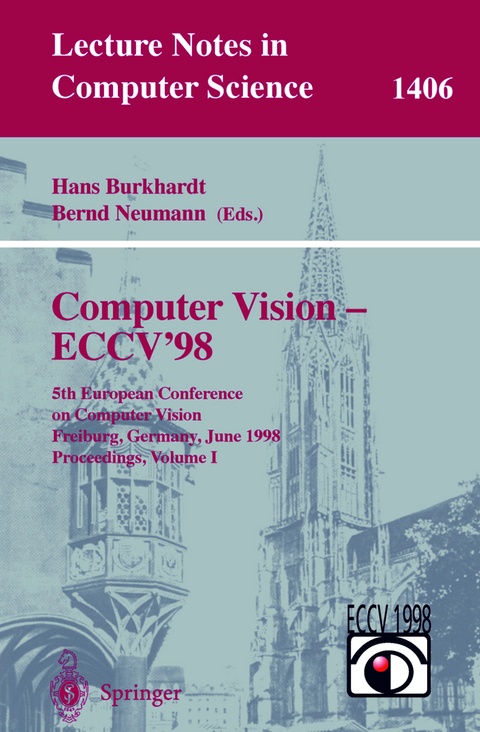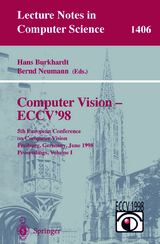Computer Vision - ECCV'98
Springer Berlin (Verlag)
978-3-540-64569-6 (ISBN)
A common framework for multiple view tensors.- Computation of the quadrifocal tensor.- Self-calibration of a 1D projective camera and its application to the self-calibration of a 2D projective camera.- Multi viewpoint stereo from uncalibrated video sequences.- Recognition of planar point configurations using the density of affine shape.- Autocalibration from planar scenes.- A new characterization of the trifocal tensor.- Threading Fundamental matrices.- Use your hand as a 3-D mouse, or, relative orientation from extended sequences of sparse point and line correspondences using the affine trifocal tensor.- Do we really need an accurate calibration pattern to achieve a reliable camera calibration?.- Optimal estimation of three-dimensional rotation and reliability evaluation.- From regular images to animated heads: A least squares approach.- Stereo vision-based navigation in unknown indoor environment.- Epipolar geometry for panoramic cameras.- Occlusions, discontinuities, and epipolar lines in stereo.- Symmetry in perspective.- Projective and illumination invariant representation of disjoint shapes.- Robust techniques for the estimation of structure from motion in the uncalibrated case.- A factorization method for projective and Euclidean reconstruction from multiple perspective views via iterative depth estimation.- Automatic camera recovery for closed or open image sequences.- Structure and motion from points, lines and conics with affine cameras.- Simultaneous estimation of viewing geometry and structure.- What is computed by structure from motion algorithms?.- Complete dense stereovision using level set methods.- The geometry and matching of curves in multiple views.- Automatic modelling and 3D reconstruction of urban house roofs from high resolution aerial imagery.- Closed-form solutions for the Euclidean calibration of a stereo rig.- Is machine colour constancy good enough?.- Colour model selection and adaptation in dynamic scenes.- Comprehensive colour image normalization.- Invariant-based shape retrieval in pictorial databases.- Concerning Bayesian motion segmentation, model averaging, matching and the trifocal tensor.- Self inducing relational distance and its application to image segmentation.- Contour continuity in region based image segmentation.- On spatial quantization of color images.- Using Ifs and moments to build a quasi invariant image index.- Determining a structured spatio-temporal representation of video content for efficient visualization and indexing.- Demosaicing: Image reconstruction from color CCD samples.- Perceptual smoothing and segmentation of colour textures.- Visual recognition using local appearance.- A factorization approach to grouping.- Faithful least-squares fitting of spheres, cylinders, cones and tori for reliable segmentation.- Multi-step procedures for the localization of 2D and 3D point landmarks and automatic ROI size selection.- Object oriented motion estimation in color image sequences.- Multi-scale andsnakes for automatic road extraction.- A model-free voting approach for integrating multiple cues.- Finding boundaries in natural images: A new method using point descriptors and area completion.- A smoothing filter for condensation.- Camera-based ID verification by signature tracking.- Model based tracking for navigation and segmentation.- Beginning a transition from a local to a more global point of view in model-based vehicle tracking.- View-based adaptive affine tracking.- An efficient combination of 2D and 3D shape descriptions for contour based tracking of moving objects.- 2D-object tracking based on projection-histograms.- W 4 S: A real-time system for detecting and tracking people in 2 1/2D.- Icondensation: Unifying low-level and high-level tracking in a stochastic framework.- A probabilistic framework for matching temporal trajectories: Condensation-based recognition of gestures and expressions.
| Erscheint lt. Verlag | 26.5.1998 |
|---|---|
| Reihe/Serie | Lecture Notes in Computer Science |
| Zusatzinfo | XVI, 927 p. 415 illus., 10 illus. in color. |
| Verlagsort | Berlin |
| Sprache | englisch |
| Maße | 155 x 235 mm |
| Gewicht | 1320 g |
| Themenwelt | Informatik ► Grafik / Design ► Digitale Bildverarbeitung |
| Mathematik / Informatik ► Informatik ► Software Entwicklung | |
| Informatik ► Theorie / Studium ► Künstliche Intelligenz / Robotik | |
| Schlagworte | 3-D Vision • algorithms • Bildverarbeitung • Computational Geometry • computer vision • Computervision • Epipolar Geometry • Hardcover, Softcover / Informatik, EDV/Informatik • HC/Informatik, EDV/Informatik • Image Processing • Image Segmentation • Multiple-View Geometry • Mustererkennung • Navigation • robot • Segmentation • Text • Video |
| ISBN-10 | 3-540-64569-1 / 3540645691 |
| ISBN-13 | 978-3-540-64569-6 / 9783540645696 |
| Zustand | Neuware |
| Informationen gemäß Produktsicherheitsverordnung (GPSR) | |
| Haben Sie eine Frage zum Produkt? |
aus dem Bereich




